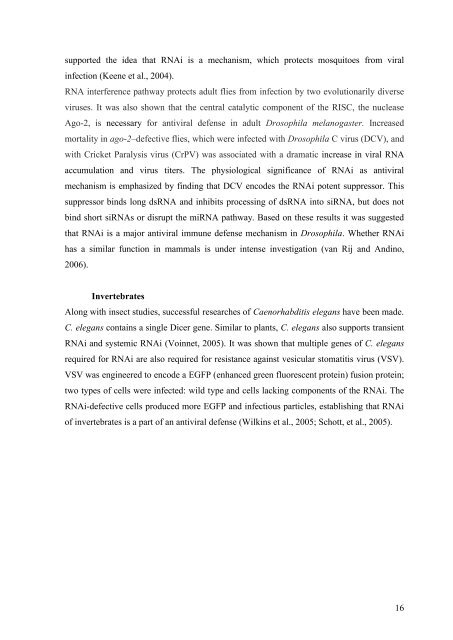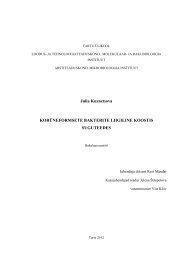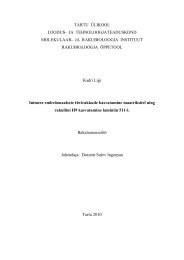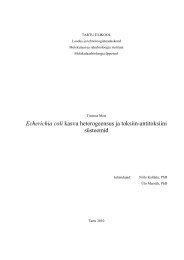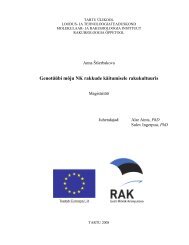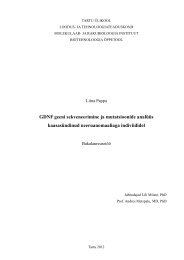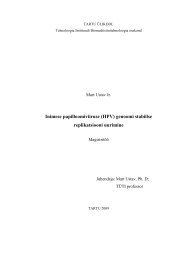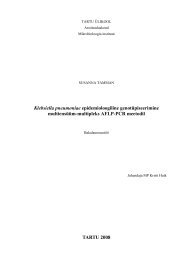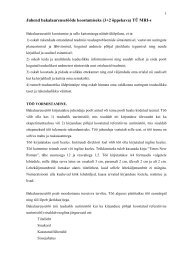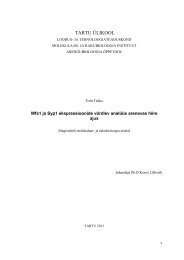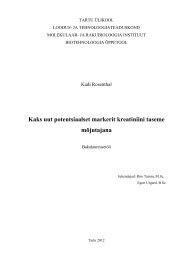Viruses and RNA interference in mammalian cells
Viruses and RNA interference in mammalian cells
Viruses and RNA interference in mammalian cells
Create successful ePaper yourself
Turn your PDF publications into a flip-book with our unique Google optimized e-Paper software.
supported the idea that <strong>RNA</strong>i is a mechanism, which protects mosquitoes from viral<br />
<strong>in</strong>fection (Keene et al., 2004).<br />
<strong>RNA</strong> <strong><strong>in</strong>terference</strong> pathway protects adult flies from <strong>in</strong>fection by two evolutionarily diverse<br />
viruses. It was also shown that the central catalytic component of the RISC, the nuclease<br />
Ago-2, is necessary for antiviral defense <strong>in</strong> adult Drosophila melanogaster. Increased<br />
mortality <strong>in</strong> ago-2–defective flies, which were <strong>in</strong>fected with Drosophila C virus (DCV), <strong>and</strong><br />
with Cricket Paralysis virus (CrPV) was associated with a dramatic <strong>in</strong>crease <strong>in</strong> viral <strong>RNA</strong><br />
accumulation <strong>and</strong> virus titers. The physiological significance of <strong>RNA</strong>i as antiviral<br />
mechanism is emphasized by f<strong>in</strong>d<strong>in</strong>g that DCV encodes the <strong>RNA</strong>i potent suppressor. This<br />
suppressor b<strong>in</strong>ds long ds<strong>RNA</strong> <strong>and</strong> <strong>in</strong>hibits process<strong>in</strong>g of ds<strong>RNA</strong> <strong>in</strong>to si<strong>RNA</strong>, but does not<br />
b<strong>in</strong>d short si<strong>RNA</strong>s or disrupt the mi<strong>RNA</strong> pathway. Based on these results it was suggested<br />
that <strong>RNA</strong>i is a major antiviral immune defense mechanism <strong>in</strong> Drosophila. Whether <strong>RNA</strong>i<br />
has a similar function <strong>in</strong> mammals is under <strong>in</strong>tense <strong>in</strong>vestigation (van Rij <strong>and</strong> And<strong>in</strong>o,<br />
2006).<br />
Invertebrates<br />
Along with <strong>in</strong>sect studies, successful researches of Caenorhabditis elegans have been made.<br />
C. elegans conta<strong>in</strong>s a s<strong>in</strong>gle Dicer gene. Similar to plants, C. elegans also supports transient<br />
<strong>RNA</strong>i <strong>and</strong> systemic <strong>RNA</strong>i (Vo<strong>in</strong>net, 2005). It was shown that multiple genes of C. elegans<br />
required for <strong>RNA</strong>i are also required for resistance aga<strong>in</strong>st vesicular stomatitis virus (VSV).<br />
VSV was eng<strong>in</strong>eered to encode a EGFP (enhanced green fluorescent prote<strong>in</strong>) fusion prote<strong>in</strong>;<br />
two types of <strong>cells</strong> were <strong>in</strong>fected: wild type <strong>and</strong> <strong>cells</strong> lack<strong>in</strong>g components of the <strong>RNA</strong>i. The<br />
<strong>RNA</strong>i-defective <strong>cells</strong> produced more EGFP <strong>and</strong> <strong>in</strong>fectious particles, establish<strong>in</strong>g that <strong>RNA</strong>i<br />
of <strong>in</strong>vertebrates is a part of an antiviral defense (Wilk<strong>in</strong>s et al., 2005; Schott, et al., 2005).<br />
16


